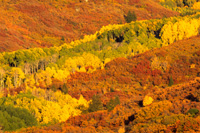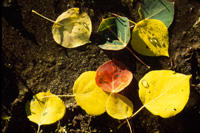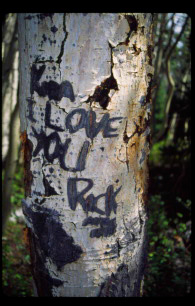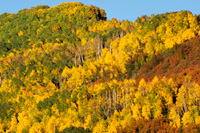Quaking aspens (Populus tremuloides) get both their common and scientific names from the quaking or trembling motion of the heart-shaped leaf blades. The blade, attached perpendicularly to the flat leaves, is borne on long flattened stems which enable the leaves to quiver in even the slightest breeze. Also referred to as “quakies,” this trembling nature of the deciduous leaves reduces the potential for wind damage.
 Aspen are one of the most widely distributed trees in North America. Growing from Alaska to Newfoundland, aspens are a signature tree of the western mountains. Here in Canyon Country, aspens grow mostly in the mountains at mid to high elevations, although lower elevation sites exist in cool pockets in the canyons or in protected north-facing alcoves. These lower locations are probably remnant populations, leftovers from the Ice Age when a cooler and wetter climate enveloped this landscape.
Aspen are one of the most widely distributed trees in North America. Growing from Alaska to Newfoundland, aspens are a signature tree of the western mountains. Here in Canyon Country, aspens grow mostly in the mountains at mid to high elevations, although lower elevation sites exist in cool pockets in the canyons or in protected north-facing alcoves. These lower locations are probably remnant populations, leftovers from the Ice Age when a cooler and wetter climate enveloped this landscape.
Members of the Willow family, aspen are related to cottonwoods, poplars and willows. Similar to these other species, aspens produce copious amounts of seeds, except the majority of aspen seeds are sterile. This is because the trees regenerate mostly through suckers sprouting from the tree’s extensive root system after a major disturbance such as a wildland fire or trunk-shearing avalanche. Arising like proverbial Phoenixes from the ashes, these quick growing sprouts regenerate an area. One historical footnote of aspen regeneration arises in Moscow in 1813 after Napoleon Bonaparte and his army reduced much of the city to ashes. The first trees to reforest the area were aspens.
To keep aspens from suckering randomly, the root systems have a hormonal resistance to sprouting. However, after a major disturbance, this chemical inhibitor breaks down and the roots send up shoots. Thus a forest of aspen is often a clone of the parent tree. If one were to consider these “forest of clones” to be from a single source, then some extensive aspen forests may represent the largest living organism on the planet.
Single entity or grove of individuals, aspen forests provide habitat for a variety of wildlife species. Deer browse on understory plants, woodpeckers excavate nest cavities in the soft trunks and other birds glean insects from the tree’s leaves. Bears rake a tree with their claws while elk rub their velvety antlers against the trunks. Their markings make lasting impression in the soft wood, but these are not the only marks found on aspen trees.

 Early settlers, wandering lovers, Basque sheepherders and other forest visitors have carved names, dates, inscriptions and devotions into aspen trees. Depending upon one’s viewpoint, these glyphs are either destructive graffiti or a treasure chest of historic value. Defined as CMT’s – culturally modified trees – these carvings provide a trunk full of history. Although carving one’s name into an aspen today is highly discouraged, the short-lived inscriptions may provide some historical significance. Of course, once the trees topple or are consumed by a fire, these inscriptions are lost forever.
Early settlers, wandering lovers, Basque sheepherders and other forest visitors have carved names, dates, inscriptions and devotions into aspen trees. Depending upon one’s viewpoint, these glyphs are either destructive graffiti or a treasure chest of historic value. Defined as CMT’s – culturally modified trees – these carvings provide a trunk full of history. Although carving one’s name into an aspen today is highly discouraged, the short-lived inscriptions may provide some historical significance. Of course, once the trees topple or are consumed by a fire, these inscriptions are lost forever.
So as summer rolls into fall, the La Sals offer an inviting location to explore. Cooler temperatures mark this transition and the shorter days signal the trees to shut down photosynthesis. As chlorophyll pigments breakdown, they unmask other pigments that produce golden, rusty or occasionally flame red colored leaves. Set against a contrast of green conifers, this spectacular display lights up the mountains translating this month into “Septemb-AH"

 Aspen are one of the most widely distributed trees in North America. Growing from Alaska to Newfoundland, aspens are a signature tree of the western mountains. Here in Canyon Country, aspens grow mostly in the mountains at mid to high elevations, although lower elevation sites exist in cool pockets in the canyons or in protected north-facing alcoves. These lower locations are probably remnant populations, leftovers from the Ice Age when a cooler and wetter climate enveloped this landscape.
Aspen are one of the most widely distributed trees in North America. Growing from Alaska to Newfoundland, aspens are a signature tree of the western mountains. Here in Canyon Country, aspens grow mostly in the mountains at mid to high elevations, although lower elevation sites exist in cool pockets in the canyons or in protected north-facing alcoves. These lower locations are probably remnant populations, leftovers from the Ice Age when a cooler and wetter climate enveloped this landscape.

 Early settlers, wandering lovers, Basque sheepherders and other forest visitors have carved names, dates, inscriptions and devotions into aspen trees. Depending upon one’s viewpoint, these glyphs are either destructive graffiti or a treasure chest of historic value. Defined as CMT’s – culturally modified trees – these carvings provide a trunk full of history. Although carving one’s name into an aspen today is highly discouraged, the short-lived inscriptions may provide some historical significance. Of course, once the trees topple or are consumed by a fire, these inscriptions are lost forever.
Early settlers, wandering lovers, Basque sheepherders and other forest visitors have carved names, dates, inscriptions and devotions into aspen trees. Depending upon one’s viewpoint, these glyphs are either destructive graffiti or a treasure chest of historic value. Defined as CMT’s – culturally modified trees – these carvings provide a trunk full of history. Although carving one’s name into an aspen today is highly discouraged, the short-lived inscriptions may provide some historical significance. Of course, once the trees topple or are consumed by a fire, these inscriptions are lost forever.